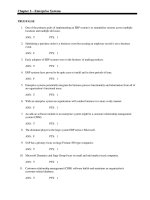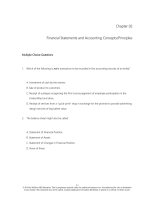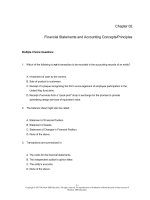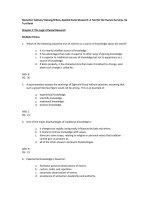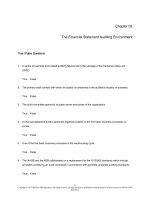Horngrens accounting the managerial chapters 10th edition nobles test bank
Bạn đang xem bản rút gọn của tài liệu. Xem và tải ngay bản đầy đủ của tài liệu tại đây (508.91 KB, 74 trang )
Horngren's Financial & Managerial Accounting, The Managerial Chapters, 4e (Nobles)
Chapter 16 Introduction to Managerial Accounting
Learning Objective 16-1
1) Managerial accounting focuses on providing information for internal planning and control.
Answer: TRUE
Diff: 1
LO: 16-1
AACSB: Concept
AICPA Functional: Reporting
2) Financial accounting prepares reports for internal purposes, whereas managerial accounting provides
information to external stakeholders.
Answer: FALSE
Diff: 1
LO: 16-1
AACSB: Concept
AICPA Functional: Reporting
3) The IMA standards of ethical practice require managerial accountants to maintain their professional
competence.
Answer: TRUE
Diff: 1
LO: 16-1
AACSB: Ethical Understanding
AICPA Functional: Reporting
4) The accountant for Myra Lido deliberately deferred cash payments for business expenses in order to
record a higher operating cash flow for the company. As long as the amount was not material, this would
not be considered unethical behavior.
Answer: FALSE
Diff: 1
LO: 16-1
AACSB: Ethical Understanding
AICPA Functional: Reporting
5) Financial statements prepared for investors and creditors often include forward-looking information
because they make decisions based on a company's future prospects.
Answer: FALSE
Diff: 1
LO: 16-1
AACSB: Concept
AICPA Functional: Reporting
1
Copyright © 2014 Pearson Education, Inc.
6) Management accounting reporting by a public firm is required to follow the rules of GAAP and
guidelines of the Securities Exchange Commission.
Answer: FALSE
Diff: 1
LO: 16-1
AACSB: Concept
AICPA Functional: Reporting
7) A budget is a managerial accounting tool used in the planning process.
Answer: TRUE
Diff: 1
LO: 16-1
AACSB: Concept
AICPA Functional: Reporting
8) Financial reporting is typically much more detailed than managerial accounting.
Answer: FALSE
Diff: 1
LO: 16-1
AACSB: Concept
AICPA Functional: Reporting
9) The IMA Standards of Ethical Practice include confidentiality, competence, credibility, and integrity.
Answer: TRUE
Diff: 1
LO: 16-1
AACSB: Concept
AICPA Functional: Reporting
10) ERP systems can integrate all of a company's functions, departments, and data into a single system.
Answer: TRUE
Diff: 1
LO: 16-1
AACSB: Concept
AICPA Functional: Reporting
11) Which of the following is an objective of management accounting?
A) to generate financial statements of a company for tax reporting
B) to provide information to business managers to assist them in controlling their business
C) to provide information to shareholders to assist them with their investment decisions
D) to ensure that the reports produced for internal and external business purposes are GAAP compliant
Answer: B
Diff: 1
LO: 16-1
AACSB: Concept
AICPA Functional: Reporting
2
Copyright © 2014 Pearson Education, Inc.
12) Which of the following statements is true of management accounting?
A) The external stakeholders of a company are the primary users of management accounting.
B) Management accounting information is used to help managers plan and control their operations.
C) An external audit by an independent CPA is required for management accounting information.
D) Management accounting information must comply with Generally Accepted Accounting Principles.
Answer: B
Diff: 1
LO: 16-1
AACSB: Concept
AICPA Functional: Reporting
13) Management accounting information of a company is primarily used by ________.
A) its customers to understand the pricing of the product
B) its creditors to understand the credibility of the business
C) its employees to plan and control operations
D) its investors to make their investment decisions
Answer: C
Diff: 1
LO: 16-1
AACSB: Concept
AICPA Functional: Reporting
14) Which of the following statements is true of financial accounting?
A) It provides information to investors needed for their investment decisions.
B) It provides forward-looking information needed for managing and delegating operations.
C) It focuses on detailed reports for parts of the company rather than the whole company.
D) It focuses on planning and controlling day-to-day operations.
Answer: A
Diff: 1
LO: 16-1
AACSB: Concept
AICPA Functional: Reporting
15) Management's accountability to its suppliers and vendors is to ________.
A) provide products to customers that are safe and free of defects
B) obey laws and pay taxes timely
C) provide a return on shareholders' investment
D) make timely payments and comply with contract terms
Answer: D
Diff: 1
LO: 16-1
AACSB: Concept
AICPA Functional: Reporting
3
Copyright © 2014 Pearson Education, Inc.
16) How is the management of a company accountable to its employees?
A) The management must provide products that are safe and free of defects.
B) The management must provide a safe workplace.
C) The management must ensure that it earns a net positive return on its investments.
D) The management must ensure the business is environmentally responsible to its community.
Answer: B
Diff: 1
LO: 16-1
AACSB: Concept
AICPA Functional: Reporting
17) Management of a company is accountable to ________ for obeying laws and paying taxes.
A) the natural environment
B) its asset vendors
C) the securities exchange
D) the government
Answer: D
Diff: 1
LO: 16-1
AACSB: Concept
AICPA Functional: Reporting
18) In which of the following ways is the management of a company accountable to its communities?
A) making timely interest payments to creditors and dividend payments to investors
B) ensuring the company's environmental impact is not harmful to its area of operations
C) providing a capital return on the shareholders' investment
D) repaying principal and interest to the suppliers
Answer: B
Diff: 1
LO: 16-1
AACSB: Concept
AICPA Functional: Reporting
19) Managerial accounting includes the planning function. Which of the following items would be part of
the planning function of a business's managerial accounting?
A) comparing actual performance to previously budgeted amounts
B) creating detailed budgets
C) implementing operational plans
D) evaluating results of operations
Answer: B
Diff: 1
LO: 16-1
AACSB: Concept
AICPA Functional: Reporting
4
Copyright © 2014 Pearson Education, Inc.
20) Comparing actual performance to previously budgeted amounts is part of the ________.
A) controlling function of managerial accounting
B) planning function of managerial accounting
C) reporting function of managerial accounting
D) organizing function of managerial accounting
Answer: A
Diff: 1
LO: 16-1
AACSB: Concept
AICPA Functional: Reporting
21) Which of the following is the primary objective of managerial accounting?
A) providing information that managers need to make operational decisions
B) providing historical data to investors and creditors
C) providing summarized results of operations
D) providing information to comply with laws and regulations of government bodies
Answer: A
Diff: 1
LO: 16-1
AACSB: Concept
AICPA Functional: Reporting
22) Which of the following is the primary focus of financial accounting?
A) providing information that managers need to make operational decisions
B) providing summarized information on operational results to investors and creditors
C) providing budgets for future periods
D) providing highly detailed information on product lines, regions, and divisions
Answer: B
Diff: 1
LO: 16-1
AACSB: Concept
AICPA Functional: Reporting
23) ________ is a philosophy of continuous improvement of products and processes.
A) Just-in-time (JIT) management
B) Enterprise resource planning (ERP)
C) Supply chain management (SCM)
D) Total quality management (TQM)
Answer: D
Diff: 1
LO: 16-1
AACSB: Concept
AICPA Functional: Reporting
5
Copyright © 2014 Pearson Education, Inc.
24) Which of the following describes a system in which suppliers deliver materials at the time they are
needed and finished units are completed when customer orders need to be filled?
A) Supply chain management (SCM)
B) Just-in-time (JIT) management
C) Enterprise resource planning (ERP)
D) Total quality management (TQM)
Answer: B
Diff: 1
LO: 16-1
AACSB: Concept
AICPA Functional: Reporting
25) What is total quality management (TQM)?
A) a philosophy of supplying customers with superior products and services
B) an exchange of information with suppliers and customers to create efficient and effective processes
C) a software system that integrates a company's functions, departments and data into a single system
D) a system which speeds the transformation of raw materials into finished products
Answer: A
Diff: 1
LO: 16-1
AACSB: Concept
AICPA Functional: Reporting
26) An enterprise resource planning system (ERP) ________.
A) is a cost management system in which a company produces products just in time to satisfy needs
B) requires the implementation of total quality management
C) integrates all worldwide functions, departments and data of a company into a single system
D) cannot be implemented in service companies
Answer: C
Diff: 1
LO: 16-1
AACSB: Concept
AICPA Functional: Reporting
27) Which of the following correctly describes just-in-time (JIT) inventory management?
A) It is a production approach that maintains surplus goods at each stage of manufacture.
B) It is an inventory purchase approach that seeks purchase discounts on buying large quantities.
C) It is a cost management approach that focuses on maintaining lean inventory levels.
D) It is an inventory approach which stockpiles raw materials to protect against supply interruptions.
Answer: C
Diff: 2
LO: 16-1
AACSB: Concept
AICPA Functional: Reporting
6
Copyright © 2014 Pearson Education, Inc.
28) Which of the following is true of just-in-time (JIT) inventory management?
A) It results in more storage and insurance cost.
B) It is a system in which the company produces product only after receiving an order.
C) It promotes surplus inventory to prevent production shut-down in case of supply interruptions.
D) It requires a surplus inventory of finished goods to ensure timely, or just-in-time, delivery to
customers.
Answer: B
Diff: 2
LO: 16-1
AACSB: Concept
AICPA Functional: Reporting
29) Which of the following is a philosophy designed to integrate all organizational areas in order to
provide customers with superior products and services, while meeting organizational goals throughout
the value chain?
A) Supply chain management (SCM)
B) Just-in-time (JIT) management
C) Enterprise resource planning (ERP)
D) Total quality management (TQM)
Answer: D
Diff: 1
LO: 16-1
AACSB: Concept
AICPA Functional: Reporting
30) The whole sequence of activities that add value to a company's products and services is called
________.
A) the value chain
B) the planning process
C) TQM production chain
D) enterprise resource planning
Answer: A
Diff: 1
LO: 16-1
AACSB: Concept
AICPA Functional: Reporting
31) Which of the following is one of the key standards of ethical practice published by the Institute of
Management Accountants (IMA)?
A) objectivity
B) environmental sensitivity
C) technicality
D) confidentiality
Answer: D
Diff: 1
LO: 16-1
AACSB: Ethical Understanding
AICPA Functional: Reporting
7
Copyright © 2014 Pearson Education, Inc.
32) Seria Inc. has received a bulk order from an overseas client. As a result, the reported earnings of this
year is expected to be significantly higher than the estimates of financial analysts. Joshua, an accountant
at Seria, tells this to one of his friends. Which of the IMA standards has Joshua violated?
A) objectivity
B) competence
C) confidentiality
D) technicality
Answer: C
Diff: 1
LO: 16-1
AACSB: Reflective Thinking
AICPA Functional: Reporting
33) You did not understand what the term accrual meant and failed to accrue the interest due at the end
of the year on the company's bonds. Which of the IMA standards appears to have been violated here?
A) integrity
B) confidentiality
C) competence
D) objectivity
Answer: C
Diff: 1
LO: 16-1
AACSB: Reflective Thinking
AICPA Functional: Reporting
Learning Objective 16-2
1) Product costs, such as direct materials, are expensed in the period they were paid.
Answer: FALSE
Diff: 1
LO: 16-2
AACSB: Application
AICPA Functional: Reporting
2) Unlike merchandising companies, income statements of service companies include cost of goods sold
as a line item.
Answer: FALSE
Diff: 1
LO: 16-2
AACSB: Application
AICPA Functional: Reporting
3) Manufacturing businesses have inventory accounts, but merchandising businesses do not.
Answer: FALSE
Diff: 1
LO: 16-2
AACSB: Concept
AICPA Functional: Reporting
8
Copyright © 2014 Pearson Education, Inc.
4) Manufacturing businesses produce their own products, but merchandising businesses do not.
Answer: TRUE
Diff: 1
LO: 16-2
AACSB: Concept
AICPA Functional: Reporting
5) If Royal Inc. purchases each unit of product X for $100 and can sell it in the market for $135; the selling
price of the product for Royal would be $100.
Answer: FALSE
Diff: 1
LO: 16-2
AACSB: Application
AICPA Functional: Reporting
6) Merchandising companies, like service companies, do not have a Cost of Goods Sold account.
Answer: FALSE
Diff: 1
LO: 16-2
AACSB: Application
AICPA Functional: Reporting
7) Selling and administrative expenses are subtracted from the cost of goods sold to obtain operating
profit.
Answer: TRUE
Diff: 1
LO: 16-2
AACSB: Concept
AICPA Functional: Reporting
8) For external reporting purposes, GAAP requires companies to treat period costs as assets.
Answer: FALSE
Diff: 1
LO: 16-2
AACSB: Application
AICPA Functional: Reporting
9) The primary activity of manufacturing businesses is to purchase goods from a wholesaler and resell
them.
Answer: FALSE
Diff: 1
LO: 16-2
AACSB: Concept
AICPA Functional: Reporting
10) Service companies include companies that provide health care, communication, banking, and other
important benefits to society.
Answer: TRUE
Diff: 1
LO: 16-2
AACSB: Concept
AICPA Functional: Reporting
9
Copyright © 2014 Pearson Education, Inc.
11) The income statement of a service company will most likely include ________.
A) salary expense
B) factory overhead
C) cost of goods sold
D) direct materials
Answer: A
Diff: 1
LO: 16-2
AACSB: Application
AICPA Functional: Reporting
12) Which of the following is true of service companies?
A) All costs of service companies are product costs.
B) Service companies modify and resell products they buy from manufacturers.
C) Revenues of service companies are only recorded on cash receipt.
D) Service companies carry no inventories of products for sale.
Answer: D
Diff: 1
LO: 16-2
AACSB: Concept
AICPA Functional: Reporting
13) For a manufacturing company, which of the following is a period cost?
A) direct materials
B) office rent
C) wages expense of factory workers
D) indirect materials
Answer: B
Diff: 1
LO: 16-2
AACSB: Application
AICPA Functional: Reporting
14) One of the primary activities of Rex Inc. is to purchase hats from Viva Inc. in Texas and sell them to its
customers in Washington for a profit. It is likely that Rex is a ________.
A) manufacturing company
B) hybrid company
C) service company
D) merchandising company
Answer: D
Diff: 1
LO: 16-2
AACSB: Application
AICPA Functional: Reporting
10
Copyright © 2014 Pearson Education, Inc.
15) Which of the following is most likely a service company?
A) a law firm
B) a car dealership
C) a grocery store
D) a patisserie
Answer: A
Diff: 1
LO: 16-2
AACSB: Application
AICPA Functional: Reporting
16) A company that uses labor, equipment, supplies, and facilities to convert raw materials into finished
products is a ________.
A) merchandising company
B) manufacturing company
C) service company
D) trading company
Answer: B
Diff: 1
LO: 16-2
AACSB: Concept
AICPA Functional: Reporting
17) Goods that have been started in the manufacturing process but are not yet complete are included in
the ________.
A) Finished Goods Inventory account
B) Work-in-Process Inventory account
C) Raw Materials Inventory account
D) Cost of Goods Sold account.
Answer: B
Diff: 1
LO: 16-2
AACSB: Concept
AICPA Functional: Reporting
18) Which of the following would appear as a line item on the income statements of both, a merchandiser
and a manufacturer?
A) Direct labor
B) Cost of goods manufactured
C) Direct materials
D) Cost of goods sold
Answer: D
Diff: 1
LO: 16-2
AACSB: Concept
AICPA Functional: Reporting
11
Copyright © 2014 Pearson Education, Inc.
19) Damsel Inc. is a large manufacturer of auto tires. Damsel has provided the following information:
Sales Revenue
Beginning Finished Goods Inventory
Cost of Goods Sold
Cost of Goods Manufactured
$45,500
1,500
32,500
35,000
Calculate the amount of ending finished goods inventory reported in Damsel's balance sheet.
A) $10,500
B) $36,500
C) $4,000
D) $3,500
Answer: C
Explanation: C)
Beginning Finished Goods Inventory
$1,500
Add: Cost of Goods Manufactured
35,000
Cost of Goods Available for Sale
36,500
Less: Cost of Goods Sold
-32,500
Ending Finished Goods Inventory
$4,000
Diff: 2
LO: 16-2
AACSB: Concept
AICPA Functional: Reporting
20) The balance sheet of a ________ company will show Work-in-Process Inventory as a line item.
A) manufacturing
B) merchandising
C) service
D) trading
Answer: A
Diff: 1
LO: 16-2
AACSB: Concept
AICPA Functional: Reporting
12
Copyright © 2014 Pearson Education, Inc.
21) Partial income statements of Company A and Company B are provided below:
Which of the following statements is true?
A) Company A is a merchandising company.
B) Company B is a manufacturing company.
C) Company A is a manufacturing company.
D) Company A is a service company.
Answer: D
Diff: 1
LO: 16-2
AACSB: Application
AICPA Functional: Reporting
22) Product costs are expensed ________.
A) when the products are consumed or sold
B) when the accounting period they are incurred in comes to an end
C) when the products are transferred to Work-in-Process Inventory account
D) when the market value of products goes above the recorded value
Answer: A
Diff: 1
LO: 16-2
AACSB: Concept
AICPA Functional: Reporting
23) The Work-in-Process Inventory account includes the ________./
A) goods that are ready to be sold
B) goods that are partially completed
C) goods that have been sold in the market
D) goods that are damaged during production
Answer: B
Diff: 1
LO: 16-2
AACSB: Concept
AICPA Functional: Reporting
13
Copyright © 2014 Pearson Education, Inc.
24) Which of the following is true of finished goods inventory?
A) Finished Goods Inventory is an account used by a manufacturer and includes completed goods that
have not yet been sold.
B) Finished Goods Inventory is an account used by a merchandiser and includes completed goods that
have not yet been sold.
C) Finished Goods Inventory is an account used by service companies in lieu of raw materials inventory.
D) Finished Goods Inventory is an account used by a manufacturer in lieu of raw materials inventory.
Answer: A
Diff: 1
LO: 16-2
AACSB: Concept
AICPA Functional: Reporting
25) Which of the following is true of product costs?
A) They are expensed in the period they are paid.
B) For external reporting, GAAP requires that they be expensed before the products are sold.
C) They are first recorded in an inventory account.
D) For merchandising companies, product costs do not include freight costs.
Answer: C
Diff: 1
LO: 16-2
AACSB: Concept
AICPA Functional: Reporting
26) Crystal Inc. is a merchandiser of stone ornaments. It sold 15,000 units in 2015. The company has
provided the following information:
Sales Revenue
Purchases (excluding freight in)
Selling and Administrative Expenses
Freight In
Beginning Merchandise Inventory
Ending Merchandise Inventory
$557,000
300,000
69,000
15,000
45,000
55,700
How much is the gross profit for 2015?
A) $183,700
B) $304,300
C) $252,700
D) $257,000
Answer: C
Explanation: C) $304,300 (Cost of Goods Sold) = $45,000 (Beginning Merchandise Inventory) + $300,000
(Purchases) + $15,000 (Freight In) - $55,700 (Ending Merchandise Inventory)
$557,000 (Sales Revenue) - $304,300 (Cost of Goods Sold) = $252,700 (Gross Profit)
Diff: 2
LO: 16-2
AACSB: Application
AICPA Functional: Measurement
14
Copyright © 2014 Pearson Education, Inc.
27) Which of the following formulas represents cost of goods sold for a merchandising business?
A) Beginning Inventory - Ending Inventory = Cost of Goods Sold
B) Purchases and Freight In - Ending Inventory = Cost of Goods Sold
C) Ending Inventory + Purchases and Freight In - Beginning Inventory = Cost of Goods Sold
D) Beginning Inventory + Purchases and Freight In - Ending Inventory = Cost of Goods Sold
Answer: D
Diff: 1
LO: 16-2
AACSB: Application
AICPA Functional: Reporting
15
Copyright © 2014 Pearson Education, Inc.
28) Amber Corporation has provided the following information of its operating activities for 2015:
Merchandise Inventory, January 1, 2015
Merchandise Inventory, December 31, 2015
Purchases
Selling and Administrative Expenses
Sales Revenue
$150,000
75,000
854,000
65,000
1,000,000
Required: Prepare Amber's income statement for the year ended December 31, 2015. Use the format
provided below:
Sales Revenue
Cost of Goods Sold
Beginning Inventory
Purchases
Cost of Goods Available for Sale
Ending Inventory
Cost of Goods Sold
Gross Profit
Selling and Administrative Expenses
Operating Income
Answer:
AMBER CORPORATION
Income Statement
Year Ended December 31, 2015
Sales Revenue
Cost of Goods Sold
Beginning Inventory
Purchases
Cost of Goods Available for Sale
Ending Inventory
Cost of Goods Sold
Gross Profit
Selling and Administrative Expenses
Operating Income
$1,000,000
$150,000
854,000
$1,004,000
-75,000
929,000
71,000
65,000
$6,000
Diff: 2
LO: 16-2
AACSB: Application
AICPA Functional: Measurement
16
Copyright © 2014 Pearson Education, Inc.
29) Excellent Inc. sells accounting textbooks. The following information summarizes Excellent's operating
activities for 2015:
Merchandise Inventory, January 1, 2015
Merchandise Inventory, December 31, 2015
Purchases
Selling and Administrative Expenses
Sales Revenue
$10,000
7,000
95,000
65,000
180,000
Required: Prepare Excellent Inc. income statement for the year ended December 31, 2015.
Answer:
EXCELLENT INC.
Income Statement
Year Ended December 31, 2015
Sales Revenue
$180,000
Cost of Goods Sold
Beginning Inventory
$10,000
Purchases
95,000
Cost of Goods Available for Sale
105,000
Ending Inventory
-7,000
Cost of Goods Sold
98,000
Gross Profit
82,000
Selling and Administrative Expenses
65,000
Operating Income
$17,000
Diff: 2
LO: 16-2
AACSB: Application
AICPA Functional: Measurement
17
Copyright © 2014 Pearson Education, Inc.
30) Simons Inc. sells plasticware. The following information summarizes Simons' operating activities for
2015:
Utilities Expense
Rent Expense
Sales Commissions Expense
Purchases of Merchandise
Inventory on January 1, 2015
Inventory on December 31, 2015
Sales Revenue
$ 65,000
10,000
32,500
260,000
65,000
97,500
650,000
Prepare an income statement for Simons Inc., a merchandiser, for the year ended December 31, 2015
using the format below:
Sales Revenue
Cost of Goods Sold
Beginning Inventory
Purchases
Cost of Goods Available for Sale
Ending Inventory
Cost of Goods Sold
Gross Profit
Selling Expenses
Sales Commissions Expense
Administrative Expenses
Rent Expense
Utilities Expense
Total Operating Expenses
Operating Income
18
Copyright © 2014 Pearson Education, Inc.
Answer:
SIMONS INC.
Income Statement
Year Ended December 31, 2015
Sales Revenue
Cost of Goods Sold
Beginning Inventory
Purchases
Cost of Goods Available for Sale
Ending Inventory
Cost of Goods Sold
Gross Profit
Selling Expenses
Sales Commissions Expense
Administrative Expenses
Rent Expense
Utilities Expense
Total Operating Expenses
Operating Income
$650,000
$65,000
260,000
325,000
-97,500
227,500
422,500
32,500
10,000
65,000
75,000
107,500
$315,000
Diff: 2
LO: 16-2
AACSB: Application
AICPA Functional: Measurement
19
Copyright © 2014 Pearson Education, Inc.
31) Best Inc., a merchandiser, sells office supplies. The following information summarizes Best's operating
activities during 2015:
Utilities Expense
Rent for Store Expense
Sales Commissions Expense
Purchases of Merchandise
Inventory on January 1, 2015
Inventory on December 31, 2015
Sales Revenue
$6,000
8,000
4,500
54,000
30,000
20,500
108,000
Required: Prepare an income statement for Best Inc. for the year ended December 31, 2015, using the
format below.
Sales Revenue
Cost of Goods Sold
Beginning Inventory
Purchases
Cost of Goods Available for Sale
Ending Inventory
Cost of Goods Sold
Gross Profit
Selling Expenses
Sales Commissions Expense
Administrative Expenses
Rent Expense
Utilities Expense
Total Operating Expenses
Operating Income
20
Copyright © 2014 Pearson Education, Inc.
Answer:
Sales Revenue
Cost of Goods Sold
Beginning Inventory
Purchases
Cost of Goods Available for Sale
Ending Inventory
Cost of Goods Sold
Gross Profit
Selling Expenses
Sales Commissions Expense
Administrative Expenses
Rent Expense
Utilities Expense
Total Operating Expenses
Operating Income
$108,000
$30,000
54,000
84,000
-20,500
63,500
44,500
4,500
8,000
6,000
18,500
$26,000
Diff: 3
LO: 16-2
AACSB: Application
AICPA Functional: Measurement
Learning Objective 16-3
1) Product costs, such as factory overhead, should be treated as an asset until the product is sold.
Answer: TRUE
Diff: 1
LO: 16-3
AACSB: Concept
AICPA Functional: Reporting
2) Manufacturing overhead includes all manufacturing costs, such as direct labor and direct materials.
Answer: FALSE
Diff: 1
LO: 16-3
AACSB: Concept
AICPA Functional: Reporting
3) Manufacturing overhead includes indirect manufacturing costs, such as insurance and depreciation on
the factory building.
Answer: TRUE
Diff: 1
LO: 16-3
AACSB: Concept
AICPA Functional: Reporting
21
Copyright © 2014 Pearson Education, Inc.
4) All costs incurred in the manufacture of final products are product costs.
Answer: TRUE
Diff: 1
LO: 16-3
AACSB: Concept
AICPA Functional: Reporting
5) The cost of direct materials cannot easily be traced to the manufactured product and therefore it is a
component of manufacturing overhead.
Answer: FALSE
Diff: 1
LO: 16-3
AACSB: Application
AICPA Functional: Reporting
6) Wages and benefits of assembly line workers are period costs.
Answer: FALSE
Diff: 1
LO: 16-3
AACSB: Concept
AICPA Functional: Measurement
7) Wages and benefits of assembly line workers are included in manufacturing overhead.
Answer: FALSE
Diff: 1
LO: 16-3
AACSB: Concept
AICPA Functional: Measurement
8) Wages and benefits of factory managers are considered as product costs.
Answer: TRUE
Diff: 1
LO: 16-3
AACSB: Concept
AICPA Functional: Measurement
9) The three categories of period costs are direct materials, direct labor, and manufacturing overhead.
Answer: FALSE
Diff: 1
LO: 16-3
AACSB: Concept
AICPA Functional: Measurement
10) Salary of a factory manager will be included in manufacturing overhead.
Answer: TRUE
Diff: 1
LO: 16-3
AACSB: Concept
AICPA Functional: Measurement
22
Copyright © 2014 Pearson Education, Inc.
11) Direct costs and indirect costs can be easily traced directly to a cost object.
Answer: FALSE
Diff: 1
LO: 16-3
AACSB: Concept
AICPA Functional: Measurement
12) In a manufacturing company, the salary of sales staff is an example of period cost.
Answer: TRUE
Diff: 1
LO: 16-3
AACSB: Concept
AICPA Functional: Measurement
13) Wages of factory janitors is considered non-manufacturing overhead as these are not directly related
to the manufacturing process.
Answer: FALSE
Diff: 1
LO: 16-3
AACSB: Concept
AICPA Functional: Measurement
14) Indirect materials costs such as lubes and cleaning fluids are product costs.
Answer: TRUE
Diff: 1
LO: 16-3
AACSB: Concept
AICPA Functional: Measurement
15) Indirect materials costs are included in manufacturing overhead.
Answer: TRUE
Diff: 1
LO: 16-3
AACSB: Concept
AICPA Functional: Measurement
16) For a manufacturer, rent paid for an office building is an example of a period cost.
Answer: TRUE
Diff: 1
LO: 16-3
AACSB: Concept
AICPA Functional: Measurement
17) Factory rent, taxes, and insurance are included in manufacturing overhead.
Answer: TRUE
Diff: 1
LO: 16-3
AACSB: Concept
AICPA Functional: Measurement
23
Copyright © 2014 Pearson Education, Inc.
18) Transportation costs paid to ship raw materials to a company warehouse are considered product
costs.
Answer: TRUE
Diff: 1
LO: 16-3
AACSB: Concept
AICPA Functional: Measurement
19) Sales commissions are included in manufacturing overhead.
Answer: FALSE
Diff: 1
LO: 16-3
AACSB: Concept
AICPA Functional: Measurement
20) In a manufacturing company, advertising and marketing costs are examples of period costs.
Answer: TRUE
Diff: 1
LO: 16-3
AACSB: Concept
AICPA Functional: Measurement
21) In a manufacturing company, advertising and marketing costs are included in manufacturing
overhead.
Answer: FALSE
Diff: 1
LO: 16-3
AACSB: Concept
AICPA Functional: Measurement
22) In a manufacturing company, accounting, legal, and administrative costs are typical examples of
product costs.
Answer: FALSE
Diff: 1
LO: 16-3
AACSB: Concept
AICPA Functional: Measurement
23) In a manufacturing company, administrative costs are included in period costs.
Answer: TRUE
Diff: 1
LO: 16-3
AACSB: Concept
AICPA Functional: Measurement
24) Repair and maintenance costs for factory equipment are product costs.
Answer: TRUE
Diff: 1
LO: 16-3
AACSB: Concept
AICPA Functional: Measurement
24
Copyright © 2014 Pearson Education, Inc.
25) Repair and maintenance costs for factory equipment are included in manufacturing overhead.
Answer: TRUE
Diff: 1
LO: 16-3
AACSB: Concept
AICPA Functional: Measurement
26) Repair and maintenance costs of vehicles used to deliver products to customers are product costs.
Answer: FALSE
Diff: 1
LO: 16-3
AACSB: Concept
AICPA Functional: Measurement
27) Repair and maintenance costs of vehicles used to deliver products to the customers are included in
manufacturing overhead.
Answer: FALSE
Diff: 1
LO: 16-3
AACSB: Concept
AICPA Functional: Measurement
28) Direct materials and direct labor are prime costs.
Answer: TRUE
Diff: 1
LO: 16-3
AACSB: Concept
AICPA Functional: Measurement
29) In manufacturing, the cost objects are often units of product.
Answer: TRUE
Diff: 1
LO: 16-3
AACSB: Concept
AICPA Functional: Measurement
30) Period costs are the ________.
A) product costs must be paid in the accounting period in which they are incurred
B) costs that are incurred and expensed during the same accounting period
C) costs related to production of products the company purchases and sells
D) same as manufacturing overhead costs
Answer: B
Diff: 2
LO: 16-3
AACSB: Concept
AICPA Functional: Reporting
25
Copyright © 2014 Pearson Education, Inc.


